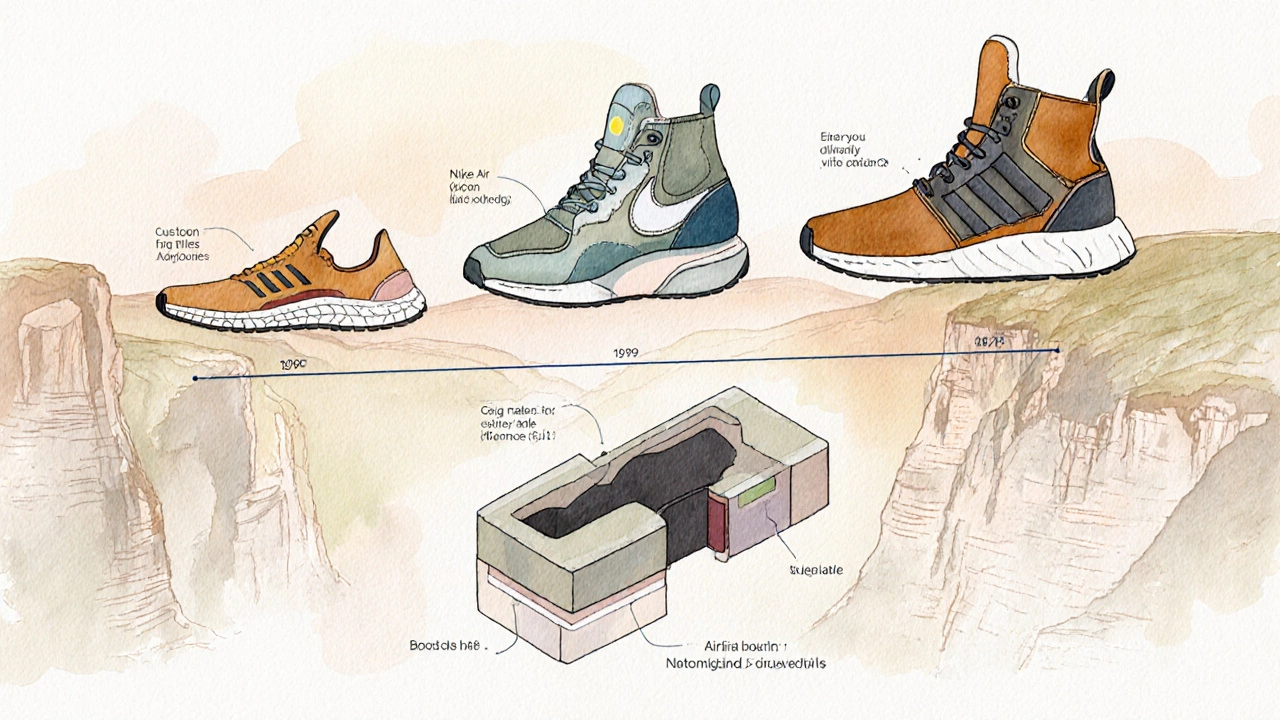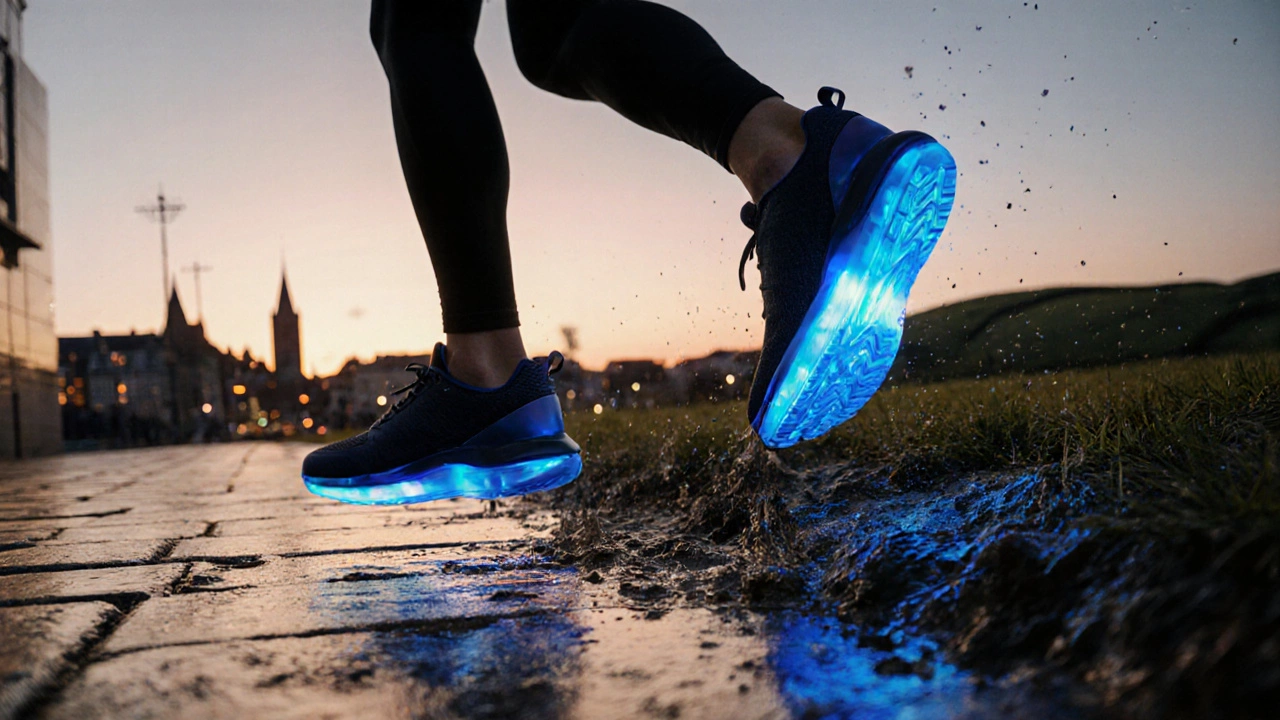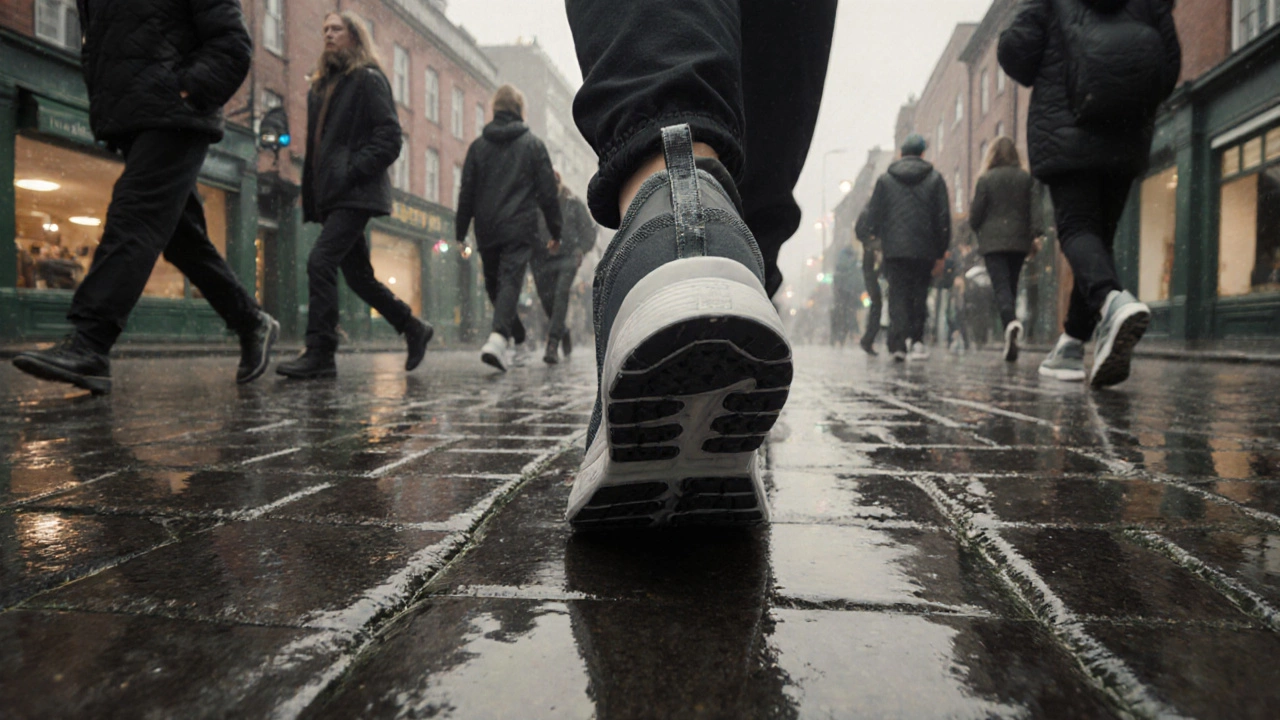Trainer Heel Height Calculator
Find Your Ideal Trainer Heel Height
Choose your primary activity and location to get recommended heel height based on Ireland's unique climate and terrain
Tip: The ideal heel height for most Irish conditions is 10-15 mm. Heels below 10 mm may lack sufficient stability for wet streets, while heights above 15 mm may reduce walking efficiency on flat urban terrain.
Walking the streets of Dublin, from the bustling Grafton Street to the historic cobbles of Temple Bar, you’ll notice a common feature on almost every pair of sneakers: a modest rise at the back. Those tiny lifts are trainers heels, and they’re not just a fashion quirk. In Ireland’s ever‑changing weather and varied terrain, that extra bit of height does a lot of heavy lifting - literally.
What are trainers and why do they have heels?
Trainers are a type of casual athletic footwear designed for everyday wear and light sport activities. They differ from formal shoes by offering flexible uppers, cushioned midsoles, and a rubber sole. The “heel” on a trainer refers to the rear part of the sole that sits under the heel bone. Though it’s a small component, it plays a pivotal role in stability, shock absorption, and overall comfort.
The functional role of a heel in a trainer
- Stability: A raised heel aligns the foot’s natural pronation, keeping the ankle stable during walking or short sprints.
- Impact reduction: When your foot hits the ground, the heel’s cushioning absorbs the shock, protecting joints - a big win for anyone navigating Dublin’s wet pavements.
- Biomechanical efficiency: A slight heel slope encourages a forward roll‑off, which improves gait efficiency and reduces fatigue on long city walks or hikes in the Wicklow Mountains.
- Design balance: The heel helps distribute the wearer’s weight evenly across the sole, preventing excessive wear on the front part of the shoe.
Historical evolution of trainer heel design
Early sneakers from the 1920s, like the classic Keds, had flat soles because they were meant for indoor use. When athletes began taking their training outdoors, manufacturers added a modest heel to better handle uneven ground. The 1970s saw the rise of the “high‑top” basketball shoe - a design that combined ankle support with a slightly higher heel for added bounce. By the late 1990s, tech giants such as Nike the multinational sportswear brand known for innovative footwear technologies and Adidas German sportswear manufacturer famous for the Boost cushioning system introduced air‑filled and foam‑based heels that could be tuned for specific activities. In Ireland, these advances arrived alongside the growth of indoor GAA facilities, where a reliable heel became essential for both training and casual wear.

Irish climate and terrain influence heel design
Rain is practically a national sport in Ireland, and that means trainers need to cope with wet, slippery surfaces. A well‑engineered heel provides extra grip when the rubber meets the mud‑slicked streets of Galway or the polished tiles of a Dublin coffee shop. Moreover, the diverse Irish landscape - from the rocky cliffs of the Cliffs of Moher to the soft peat tracks of Connemara - demands a heel that can handle varied ground without compromising comfort.
Local shoe specialists, such as Foot Locker Dublin a major retailer offering a wide range of athletic footwear across Ireland, often recommend trainers with a slightly higher heel (around 12‑15 mm) for outdoor festivals like Electric Picnic, where you’ll be on grass and uneven ground all day.
Popular brands and their heel technologies in Ireland
When Irish shoppers head to a store on Talbot Street or browse online, they typically look for a heel that matches their lifestyle:
- Nike Air Zoom a cushioning system that uses pressurized air in the heel for responsive bounce - favored by marathon runners training on the Royal Canal pathways.
- Adidas Boost a foam‑based mid‑sole technology that offers energy return and a slightly higher heel stack - popular among cyclists who ride the Dublin‑to‑Dún Laoghaire commuter route.
- Reebok Floatride lightweight foam that gives a low‑profile feel while still providing heel cushioning - a go‑to for college students walking between Trinity College and the National Library.
- Irish Shoe Company a home‑grown brand that blends traditional leather craftsmanship with modern heel support - perfect for those who want a touch of Irish heritage with contemporary comfort.

Choosing the right heel height for your needs
Not every trainer needs the same heel. Use this quick checklist to decide what works best for you:
- Daily commute? Aim for a heel height of 10‑12 mm with good rubber traction - it keeps you steady on wet cobbles.
- Gym sessions? Look for a higher heel stack (13‑15 mm) with responsive cushioning to support jumps and side‑to‑side movements.
- Outdoor hikes? Choose a trainer with a reinforced heel counter and a slightly raised heel (12‑14 mm) to protect against uneven ground in the Wicklow or Donegal trails.
- Fashion forward? Low‑profile heels (5‑8 mm) give a sleek silhouette for city nights in Cork’s lively street scene.
Maintaining trainers with heels in Irish weather
The best heel can’t perform if you neglect care. Follow these practical tips:
- Water‑proofing: Apply a spray‑on guard after each rainy run. Brands like Scotchgard a popular fabric and shoe protectant work well on synthetic uppers.
- Cleaning the sole: Use a soft bristle brush to remove mud from the heel’s tread. This prevents slippage on the slick sidewalks of Limerick.
- Heel wear monitoring: Replace trainers when the heel tread depth drops below 2 mm - a common sign of reduced grip during the wet winter months.
- Storage: Keep shoes in a ventilated shoe rack near your front door; this avoids the musty smell that can develop in damp Irish homes.
Future trends: Adaptive heels and smart cushioning
Irish tech hubs are already testing “adaptive heel” prototypes that adjust stiffness based on terrain data from a phone’s GPS. Imagine a trainer that automatically raises its heel when you transition from a city pavement to a muddy field at the Galway Races. While still in development, these smart heels could redefine comfort for the Irish market, especially for athletes who train across both urban and rural settings.
Do all trainers need a heel?
Most modern trainers incorporate some heel height because it improves stability and shock absorption. Flat‑sole sneakers exist, but they’re usually designed for specific activities like indoor ballet or minimalist running.
What heel height is best for wet Irish streets?
A heel height of 10‑12 mm with a deep tread pattern offers enough lift for comfort while providing grip on slippery pavement.
Are there Irish brands that make trainers with specialised heels?
Yes. The Irish Shoe Company produces trainers that blend traditional leather uppers with modern heel cushioning tailored for the Irish climate.
How often should I replace trainers because of heel wear?
When the heel tread depth falls below 2 mm, it’s time to swap the shoes. In Ireland’s wet conditions, this can happen after 6‑9 months of regular use.
Can I add extra heel support to an existing pair?
Insole inserts or heel lifts from pharmacies or sports stores can boost cushioning, but they may alter fit. It’s best to choose a trainer with the right heel from the start.
